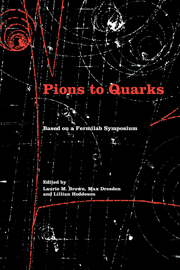Book contents
- Frontmatter
- Contents
- List of contributors
- Foreword by Leon M. Lederman
- Editors' acknowledgments
- Photographs of the symposium
- List of abbreviations
- List of notation
- I Introduction
- II Particle discoveries in cosmic rays
- III High-energy nuclear physics
- IV The new laboratory
- 9 The making of an accelerator physicist
- 10 Accelerator design and construction in the 1950s
- 11 Early history of the Cosmotron and AGS at Brookhaven
- 12 Panel on accelerators and detectors in the 1950s
- 13 Accelerators and the Midwestern Universities Research Association in the 1950s
- 14 Bubbles, sparks, and the postwar laboratory
- 15 Development of the discharge (spark) chamber in Japan in the 1950s
- 16 Early work at the Bevatron: a personal account
- 17 The discovery of the antiproton
- 18 On the antiproton discovery
- V The strange particles
- VI Weak interactions
- VII Weak interactions and parity nonconservation
- VIII The particle physics community
- IX Theories of hadrons
- X Personal overviews
- Name index
- Subject index
10 - Accelerator design and construction in the 1950s
Published online by Cambridge University Press: 07 May 2010
- Frontmatter
- Contents
- List of contributors
- Foreword by Leon M. Lederman
- Editors' acknowledgments
- Photographs of the symposium
- List of abbreviations
- List of notation
- I Introduction
- II Particle discoveries in cosmic rays
- III High-energy nuclear physics
- IV The new laboratory
- 9 The making of an accelerator physicist
- 10 Accelerator design and construction in the 1950s
- 11 Early history of the Cosmotron and AGS at Brookhaven
- 12 Panel on accelerators and detectors in the 1950s
- 13 Accelerators and the Midwestern Universities Research Association in the 1950s
- 14 Bubbles, sparks, and the postwar laboratory
- 15 Development of the discharge (spark) chamber in Japan in the 1950s
- 16 Early work at the Bevatron: a personal account
- 17 The discovery of the antiproton
- 18 On the antiproton discovery
- V The strange particles
- VI Weak interactions
- VII Weak interactions and parity nonconservation
- VIII The particle physics community
- IX Theories of hadrons
- X Personal overviews
- Name index
- Subject index
Summary
The spectacular progress in high-energy physics during the 1950s and the 1960s was due in large part to the availability of four large particle accelerators: the Cosmotron, the Bevatron, the AGS, and the CERN PS.* Although the history of the design, construction, and first operation of each of these machines is an adventurous saga in itself, relatively little attention has been devoted to it.
Many of the machine builders who could detail these histories for posterity are no longer with us. Ernest Lawrence, Leland Haworth, Stanley Livingston, George Kenneth Green, Nicholas Christofilos, Hartland Snyder, John Adams, Frank Goward, and many others are gone, leaving very little beyond journal articles in the way of records of their eventful careers. For the most part, all were too busy with the future to spend much time recording the past. Livingston and I provided a sketchy history of the development of the accelerator art in our book Particle Accelerators. But very many of the colorful events in accelerator history remain unrecorded.
In this chapter I attempt to provide a little background for accelerator history during the 1950s. At Brookhaven, we were in touch with all important accelerator projects and observed at first hand many of the unsung tribulations that beset accelerator builders, as well as the uplifting moments when their machines performed as they should.
Autobiographical note
My career covers the first thirty-two years of Brookhaven's existence. I joined the staff in the summer of 1947, Brookhaven's first year.
- Type
- Chapter
- Information
- Pions to QuarksParticle Physics in the 1950s, pp. 162 - 179Publisher: Cambridge University PressPrint publication year: 1989
- 1
- Cited by



